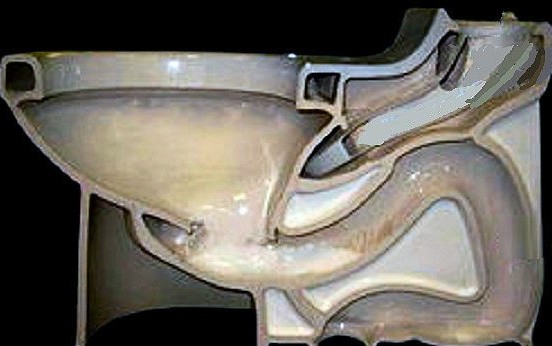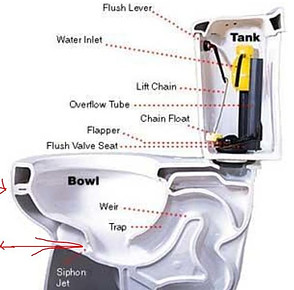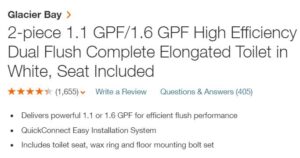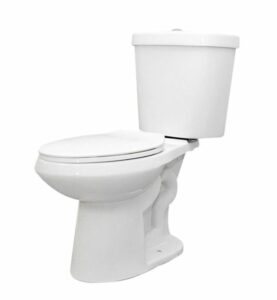How to flush the toilet.
If there isn’t a National Toilet Day there should be.
I had to fix four of them this week. Two of them were replacing old with new. It is usually a good idea to install a new toilet if possible because the newer models are designed better The new ones will be more water efficient, flush faster and cleaner and do not clog as easily.
How a toilet works.

Flush siphon gurgle gone. It’s ingeniously simple actually.
A toilet flushes on the siphon principle. When the flush handle is pushed it lifts the flapper in the bottom of the tank, the standing water in the bowl is rapidly increased in volume and the water flushes into the bowl and fills it so the water starts to flow. The flowing spinning moving water then creates a siphon suction and quickly draws all the water volume and other content over the trap and down into the sewer pipe.
When the toilet clogs from too much other content besides water or fluid, such as waste, paper, or something too large or too long to go over the trap level it will break the suction. Then the rapid increase in water volume creates a problem. Sometimes with over flooding and making a huge cleanup mess.
This can happen.
The toilet is installed over the anchor flange and drain onto a wax ring. This ring of sticky wax keeps the water sealed onto and into the drain pipe after it breaches the trap the fluid and everything in it falls by gravity down into the sewer pipe.
If the toilet anchor bolts work loose or are not tightened securely the wax ring can work around until it creates and air gap. Air can go places liquid can’t. It may not seep or leak because the fluid falls into the drain unimpeded. But it can break the siphon suction. Then the water swirls around and around but doesn’t slurp down properly. Then the waste plugs the trap and requires continual plunging and clean up. It seems like there is no apparent problem. No stoppage; not plugged. It works fine for the plumber but as soon he is gone. Swirls and puddles again. The toilet may need to be pulled up and reset with new wax ring and new anchor bolts.
Too Much Water
The volume of water in the holding tank is important. The float valve allows the water to fill the tank to a certain level and then shuts off. There is a small tube that also runs water back into the bowl to fill it to the proper level. The amount of time it takes to fill the tank should be adjusted to match the time to properly level the bowl. Excessive volume in either one can cause a less than optimal flush. Overfilling in the bowl will make the water swirl but not siphon. Too much water in the tank will start to refill the bowl too soon and compromise the slurp. It can be a little tricky to get them both adjusted just right. Especially in older style toilets with big holding tanks. A clever hack for this problem is to fill a 2 liter pop bottle with water and set into the tank. This creates a higher water level, and more water pressure through the oversize drain. This shortens the fill time and reduces the amount of water running into the bowl.
The Flush Lever and Flapper
If the Flush Lever and stopper / flapper are working correctly it should flip up, allow the tank to drain rapidly and then fall back into place onto the flush valve seat and start the tank refilling. A leaking fill valve will fill to the top of the over flow tube and run water into the bowl.
A leaking flapper will seep water into the bowl. Listen for a continual trickling sound. If the water continues to trickle it means either the water level is too high so that it is always running over the over flow tube or the flapper is not seating correctly. This often happens because the chain from the flapper to the level is too long so it tends to get under the flapper sometimes.
This will not flood the toilet because the water will simply run over the trap and down the drain. But it will cause the toilet to not flush properly because of the improper water levels that mess up the siphon action. And of course it will waste a lot of water.
Anatomy of the toilet.

This is one of the best ones I installed recently. It has three grommet bolts holding the tank to the bowl and good flush efficiency with lower water volume.
From Home Depot. Model # N2316 Store SKU #215583
How does woodworking relate to the toilet?
In many instances in Handyman or Do It Yourself projects, fixing a plumbing problem requires some preparatory repairs of walls or flooring. A leaking or flooding toilet can and often does ruin, swell, warp, distort or even rot away the floor underlayment. The shittiest part of replacing and old fixture is usually the extraction and demolition of all the old junk and crap surrounding the problem so it can be rebuilt or replaced.
If you would like to make a website like this for yourself , this the best place on the web to do it. Complete training system, Help, Support, Advice, and all inclusive: Domain Registration, Site Building, Hosting and Traffic.


